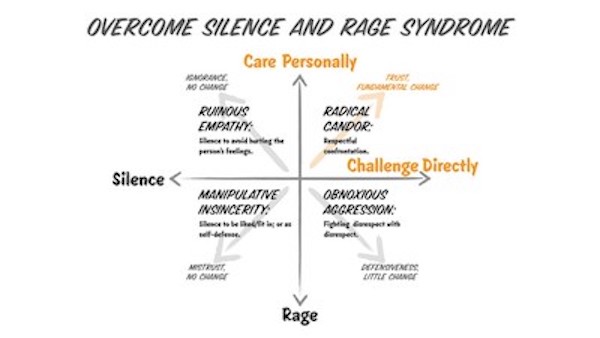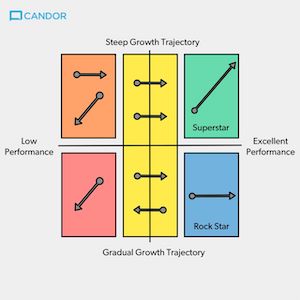Radical Candor Notes
I finally read Radical Candor after it had been recommended by several friends and colleagues. The book is a management philosophy book in the spirit of High Output Management, but the parts I found most useful were the frameworks around giving feedback and evaluating performance, which is where the book gets its title of radical candor.
The idea behind ‘Radical Candor’ as a management philosophy is that you give a damn about the people you work with. Giving a damn doesn’t mean sugar coating feedback or not hurting people’s feelings, but rather it means being honest with them to help them grow or find work they can be great at.
The Radical Candor framework

The framework is pretty straightforward. It categorizes feedback along 2 dimensions - (1) caring, and (2) challenging. Caring goes from not caring to caring personally, and challenging goes from not challenging to being upfront about it. The book argues that caring personally and challenging directly is where you want to be at (this is “Radical Candor”). This means being transparent with people, telling them where they can grow, how they can improve, and helping them get there, and doing it from a good place.
The second best you can do is to be “obnoxiously aggressive”. This means you challenge directly without coming from a place of caring. This might sound counterintuitive, but the point is that at least here you’re telling people how to be better (even if you’re hurting their feelings). Without this, you’re not giving your team the opportunity to improve.
“Ruinous empathy” is when you don’t challenge someone because you don’t want to hurt their feelings. This is ruinous because you’re not doing them any favors, just robbing them of time they could use to get better. Lastly, you have “manipulative insincerity” which is the worst of all attitudes as you neither care nor challenge the person, you’re just letting them rot.
I’m a sucker for 2x2 frameworks and found this one particularly helpful in that it helps you caliber how you’re approaching performance issues with people on your team and with yourself. It is also useful as a common framework for your team to be able to tell you if you’re being an obnoxious asshole, if they feel it’s radical candor, etc.
Superstars vs Rockstars
Another useful framework from the book is the superstar vs rockstar framework. Superstars are people in a steep growth trajectory with incredible performance. Rockstars are people with great performance in a stable growth trajectory. We tend to think that we want a team full of superstars, but the book points out that you actually need a balance because rockstars are what give your team stability (they are your rocks). If you only have superstars, your team won’t be stable - superstars will be coming and going.
In addition to being a useful model to staff your team, it’s also useful for managing the talent within your team. If someone on your team is a superstar, make sure you’re keeping them challenged by giving them growth opportunities. If you have rockstars, cherish them and don’t force them to be superstars. If you have people underperforming but on a growth trajectory, look yourself in the mirror - maybe you put them in the wrong role, maybe you’re not guiding them well enough. Lastly, if you have people in a declining growth path, it might just not be the best fit for them.

One important caveat to keep in mind is that performance is not a permanent condition. You can be a rockstar today, and a superstar tomorrow, or vice versa. You can also be a low performer in a growth trajectory or declining trajectory in one role, but a rockstar in another one. Your job as a manager is ultimately to ask the right questions and be radically candid with your team to ensure they end up where they can shine the most and be happy.